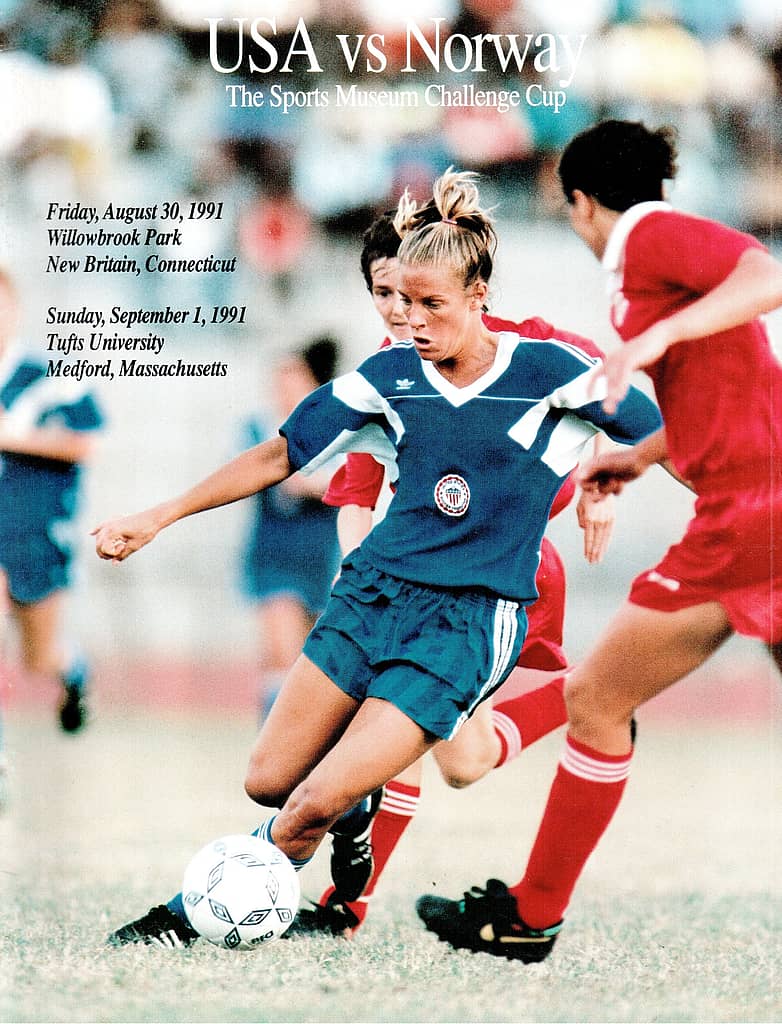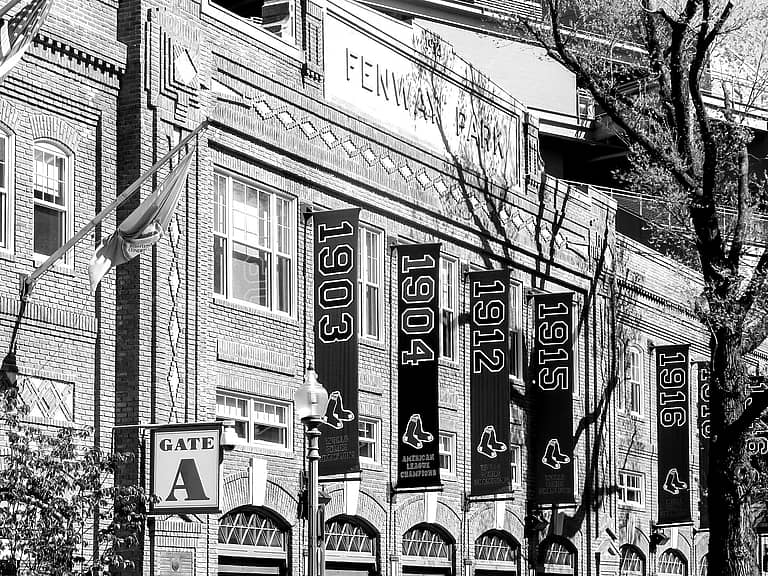It Was 33 Years Ago this September…..
That The Sports Museum, then a fledgling not-for-profit charged with preserving history, made a little of our own on a landmark occasion for women’s soccer in America. It all occurred on an afternoon in which the weather was nearly as perfect as a late summer day could be. Clear azure skies, 72 degrees, zero humidity.
For it was on the freshly lined pitch of Tufts University’s Ellis Oval before an overflow crowd of nearly seven thousand that the museum hosted the second match of a hotly contested two-game challenge cup series between the women’s national soccer teams from Norway and the United States.
At the time, the squads were evenly matched bitter rivals and acknowledged as the best in the world. Think Evert vs. Navratilova, Hagler vs. Hearns, Ward and Gatti, Bird and Magic, Steinbrenner and Lucchino, and Celtics vs. Lakers. And at the time both were making final preparations for the first-ever FIFA Women’s World Cup to be played in China less than two months later. It also marked the first-ever appearance for the US Women’s national squad in the Commonwealth of Massachusetts.
Time it was and what a time.
Within hours of the arrival of our friends from Norway, their top goalkeeper Reidun Seth complained of abdominal pain and was quickly rushed by match volunteers Peter Counsell and Ricky Copland to Mt. Auburn Hospital where she had her appendix removed almost before the lads had found a parking space near Harvard Square. Three days later, 16-year-old apprentice keeper Bente Nordby began one of the most distinguished careers in women’s soccer history.
Team Norway was housed in the Brighton Days Inn, where on one particularly memorable afternoon, following a training session at Harvard, we responded to a frantic call from the day manager with his request for us to inform the team that their custom of topless sunbathing by the pool had not yet passed muster in the 02134 zip code.
Meanwhile, a fully attired US contingent was quartered at The Charles Hotel. On a van ride to practice, we learned from the always talkative Brandi Chastain that the Charles was the best hotel that any of the players or coaching staff could recall being hosted in. We learned that just months earlier, the women played an international match in France at the same time as the U.S. men’s team. The women were housed in a youth hostel while their male counterparts scanned the wine list and contemplated ordering escargot at their four-star hotel.
Our series, which featured such players as Mia Hamm, Michelle Akers, Hege Riise, Linda Medalen, Kristine Lilly, April Heinrichs, Julie Foudy, and Needham’s own Debbie Belkin, was won by Norway on the basis of an aggregate score of 4-2, as they captured the first game by a score of 2-1 before 6000 fans at Willow Brook Park in New Britain CT and the second by an identical score at Tufts.
Both games were standing room only sellouts and raised the bar considerably for the women’s game in America. The Tufts match was also the first US women’s international ever broadcast nationwide via Sportschannel. Two months later US coach Anson Dorrance observed, “The Sports Museum Challenge Cup helped our team win the World Cup against Norway and brought our entire organization to a higher level.”
The Norwegian reaction was even more emphatic, with head coach Evan Pellerud proclaiming, “This match changed soccer.” Unfortunately, other quotes that evening were lost in the roughly eight hours of partying that followed at the Days Inn with live music supplied by The Band That Time Forgot. In a momentary pause between their renditions of “Love Shack” and “Satisfaction,” Soccer America columnist Ridge Mahoney sidled up to tournament chief Mike LaVigne and observed, “I didn’t think there were people like you, this is amazing. I don’t believe it”
Not long after the break of dawn we gathered our empties, tipped the hotel staff, and then helped our Norwegian friends bundle their gear for what was a sweet, sad drive to Logan. Many hugs and handshakes followed, along with the signing of match posters marking the conclusion of our remarkable accomplishment.
Just weeks later, as much as we rooted loudly for Team USA in China, our hearts broke a little for Norwegian defender Tina Svensson, our new friend, whose back pass was intercepted by Michelle Akers who pounced and slotted the overtime winner for the USA in dramatic fashion in Guangzhou.
Little did we know, but we’d almost single-handedly reset the proverbial bar for women’s soccer internationals in the USA. No longer would our world champions be housed in youth hostels. No longer would their matches be considered unworthy of national television exposure.
Less than nine years later the core of the US team that participated in the inaugural Sports Museum Challenge Cup played before sold-out venues across America, including the 100,000 plus at the Rose Bowl that witnessed the US victory over China in the third FIFA Women’s World Cup.
Special thanks go to the organizing committee of Michael LaVigne, Dave Cowens, Lisa White, Reider Tryggestad, Tom Bagley, Peter Counsell, and Rick Copland among others.
Seven years ago, as the Boston Breakers warmed up for a home match, Rose Lavelle, the famed US midfielder and World Cup hero, jogged to the sidelines and asked to speak to Michael LaVigne, then in his fifth decade of coaching the Boston College women’s program he’d started in the late seventies. Finding him chatting with a small group of fellow coaches, she stopped to thank him for all both he and The Sports Museum Challenge Cup group had done for women’s soccer. Thanked him for an event that occurred four years before she was born.
Two years later, she sealed the latest US World Cup victory with the second of America’s two goals in their triumph over the Netherlands.
Our champions have reshaped the universe of both soccer and women’s sports in America. Their appeals for equity, equality, and social justice resonate far beyond the sports section.
As the legendary Julie Foudy once observed, “We don’t wear cups, we win them.”
And the fact The Sports Museum played a significant role in their world-changing success endures as a source of great pride for me and my colleagues.
-Richard Johnson






